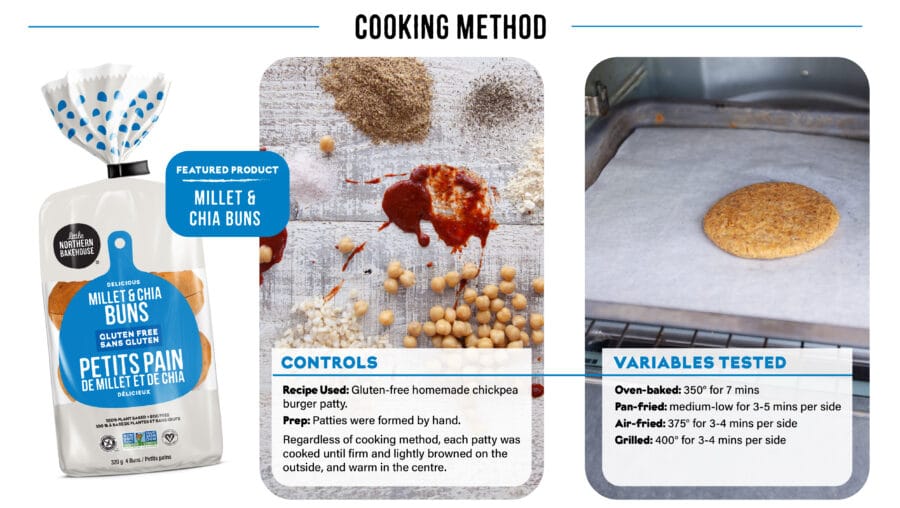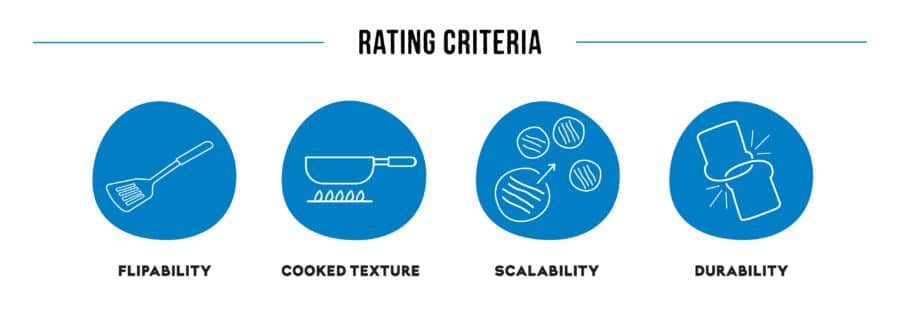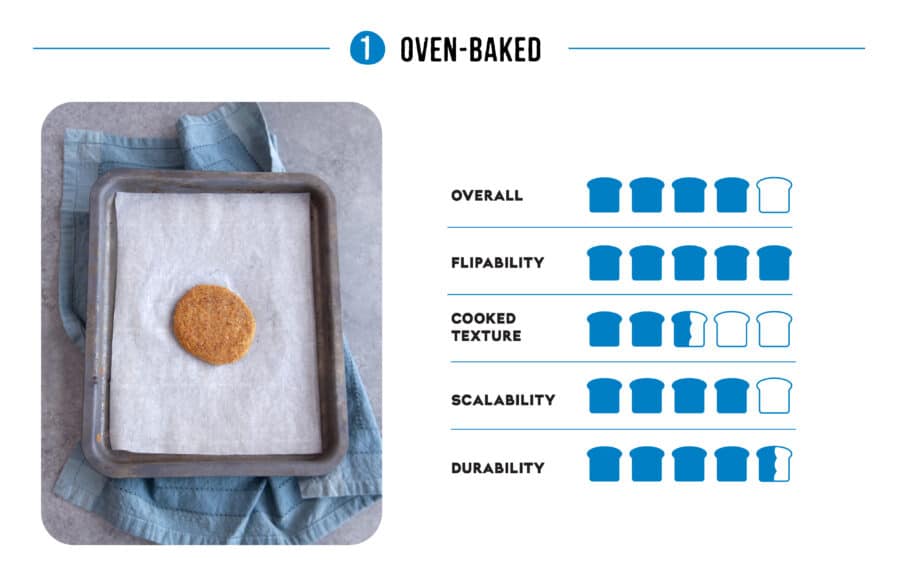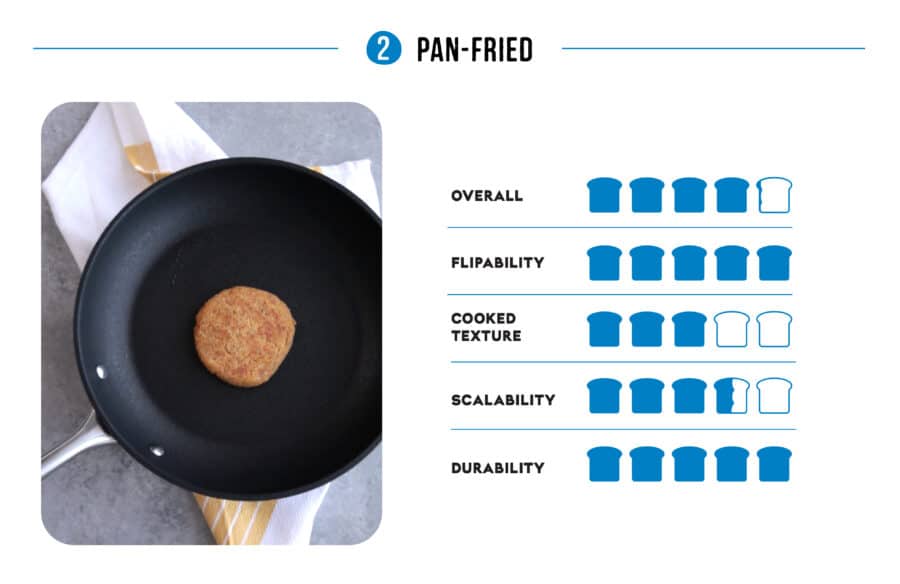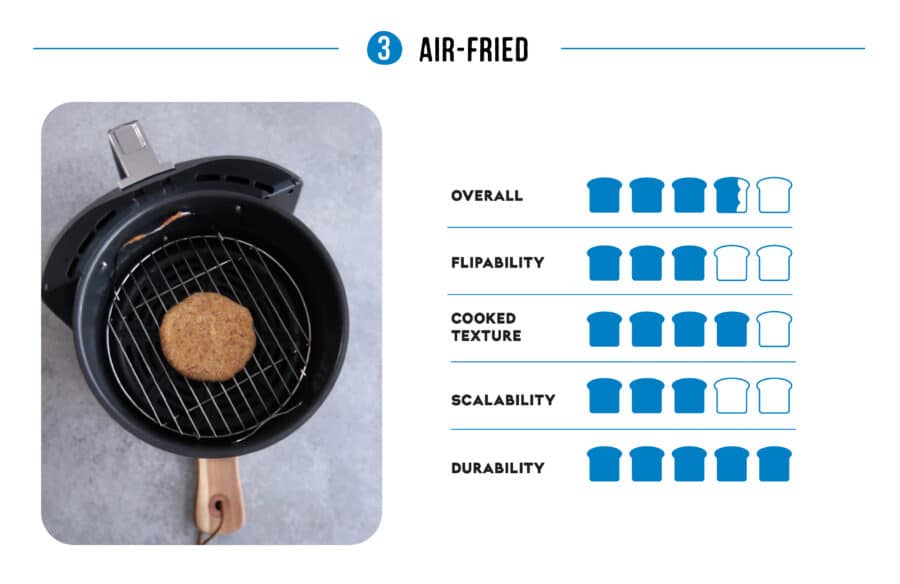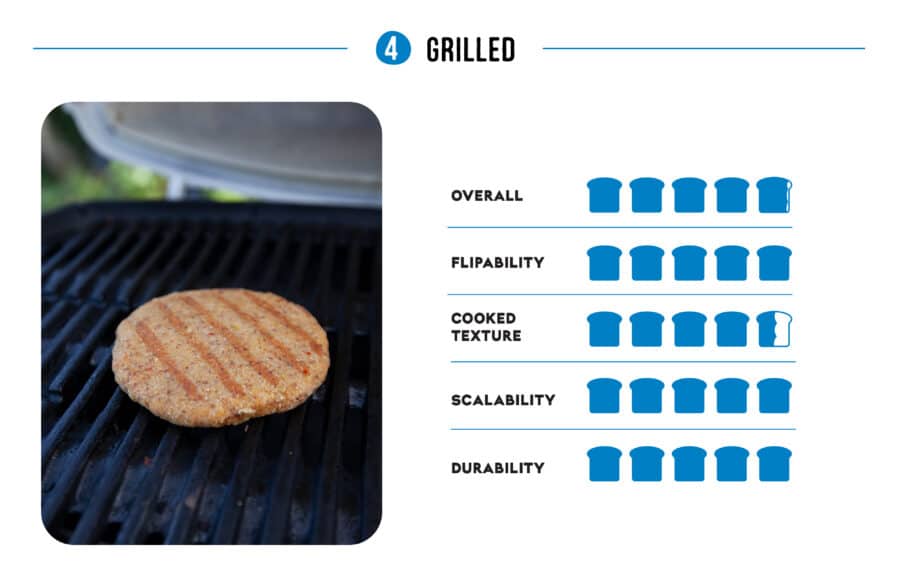Problem:
Most homemade gluten-free veggie burgers don’t hold up well on the grill. They tend to break apart and fall through the grate.
We want to know:
What is the best way to cook a homemade gluten-free veggie burger patty so that it holds together while you cook and eat it?
Controls:
- Gluten-free homemade chickpea burger patty (taken from our Buffalo Chickpea Burger recipe).
- We picked this recipe because it’s a composed veggie burger patty with a bean base—the kind more likely to fall apart on the grill than commercial veggie burgers.
- Patties were formed by hand.
- Regardless of the cooking method, each patty was cooked until firm and lightly browned on the outside, and warm in the center.
How to Cook the Best Veggie Burger
In order to determine which cooking method results in the best veggie burger, we evaluated our plant-based burgers based on four different categories:
- Flipability: Does the patty hold its integrity when flipped during cooking?
- Cooked Texture: Does it develop a nice crust? Should be lightly crispy on the outside and warm in the center.
- Scalability: A measure of the convenience of batch cooking and the ability to cook for multiple people at once.
- Durability: How well the burger holds together on its way to the bun—and in your hands!
Oven-baked
Many plant-based burger recipe instructions tell you to bake them in the oven. Any veggie burger fan who cooks knows first-hand the terrible tendency they have for going to pieces at the worst moment. Mid-flip and BAM! Your delicious dinner falls through the grates of the grill. (Which is why testing for flipability and durability is important!)
Baking veggie patties definitely spares you some of the sadness of a broken burger. And it scales up smashingly if you’re feeding a crowd. The downsides? This cooking method typically takes the longest—and turning on your oven in the heat of summer can add an unwelcome layer of sweat as temperatures soar.
Pros
- Sturdy, holds together well
- Easy to scale
Cons
- Slightly mealy and squishy in texture
Pan-fried
Pan-frying your veggie burger is another easy cooking method—and depending on the size of your pan, cooking a couple patties at a time is still doable. Although this cooking method resulted in a nice golden brown exterior, it was difficult to get the outer texture right. It just wasn’t crispy enough. However, it is still an easy and effective way to cook a plant-based burger in a pinch. We just recommend you preheat the pan prior to placing your vegan burger patties.
Pros
- Best golden colour
- Scalable (depending on the size of the pan)
Cons
- Not charred or crispy enough on the outside
Air-fried
The soaring popularity of air fryers is proof that this trendy kitchen gadget is more than a fad full of hot air. Renowned for making foods crispy on the outside and hot in the middle—fast! Adding an air fryer to our veggie burger test seemed like a no-brainer.
But while the crust was crispy and held together well, the inside texture and colour of our air-fried veggie burger were a bit of a letdown.
If you want the speed of pan-frying or grilling with some of the hands-off freedom of oven baking, an air-fried patty is a perfectly passable option—especially if you want an easy, weeknight option for one or two people. But if you’re feeding a crowd, better burger cooking methods await.
Pros
- crispy on the outside and warm on the inside
Cons
- Warm but strangely soft on the inside (as if it was steamed)
- Had a grainy, gritty, somewhat mealy texture
Grilled (brushed with oil)
We took on this whole Gluten-free Test Kitchen veggie burger challenge because so many of us had experienced the sadness of patties lost through the grill grates. But we had to find out—could there be some secret trick we hadn’t tried that would make a handmade plant-based patty hold up to our barbecued burger hopes?
We scoured the internet for hints. We read reviews that raved about fancy grill mats. We heard about hacks using an aluminum foil bed as a burger grilling base. But we landed on something far less fussy—brush both sides of the veggie burger patty with oil, give it a little chill time in the fridge, then toss it on the grill. Turns out, those two simple extra steps were the secret we were searching for!
Grilling outdoors adds that deeper, smokey-yet-fresh flavour to the plant-based burger patties. With this plant-based burger grilling hack, you can experience the joy of the real thing and get that outdoorsy, freshly grilled flavour in your veggie burgers! In our tests, we found this vegan burger grilled amazingly—even without tinfoil. It didn’t stick or break apart when flipping. And by the time it came off the grill, it had obtained those beautiful grill marks that conventional burgers are famous for.
Pros
- Held up well on the grill without the need for tinfoil
- Beautiful grill marks
- Did not fall apart nor stick to the grill
- Texture felt consistent with a conventional burger
Cons
- None
The Best Way to Cook a Veggie Burger
Keep in mind, not all homemade gluten-free veggie burgers are created equally. The best cooking method may vary depending on the recipe. But for the recipe we tested, there was one clear winner: brushing the plant-based burger patty with oil and tossing it on the grill. It was the resounding ketchup-and-mustard-covered hands-down best way to achieve the smokey, burger-y joy of the real thing.
No grill? No problem. Baking remains a tried-and-true method for veggie burger patties of all recipes and types. And a big batch of burgers baked in the oven is ready at the same time without having to babysit the barbecue. But however you choose to cook your vegan burgers, they’re always delicious on an allergy-friendly, gluten-free Little Northern Bakehouse bun.
For more gluten-free resources, sign up for our monthly newsletter at the bottom of this page. Check out our other gluten-free test kitchen for more tips, and post your makes to Facebook, Instagram, and Pinterest. (Don’t forget to tag us!)
